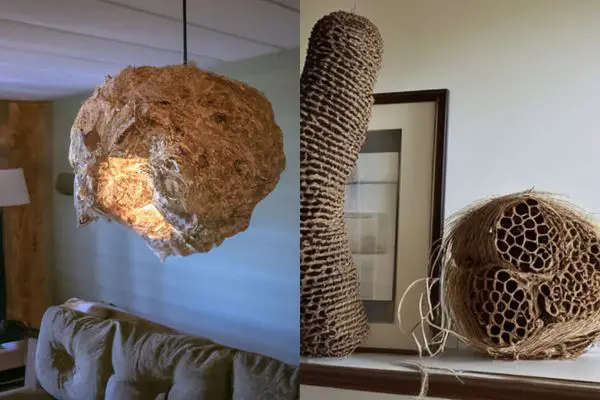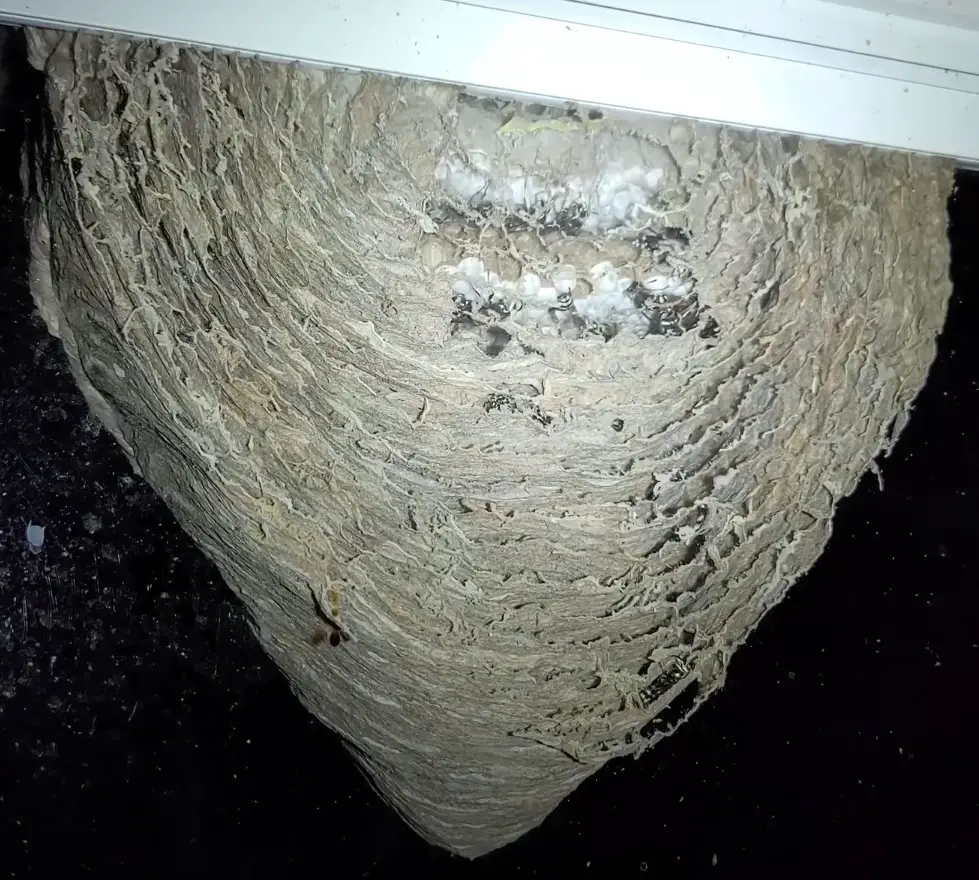You probably are not aware that there may be some extra money hanging around your house. A large, bald-faced hornet nest can bring in some cash.
They are sold in shops or online. A quick look on sites such as eBay will show hornet nests with asking prices ranging from $20 to $500 with an average price of 100$ for a bald-faced hornet nest.
If you have a hornet nest nearby and want to try selling it, you’ll need to wait until late fall or winter when it’s empty.
You certainly don’t want to mess with the nest while it’s occupied!
Bald-faced hornets will attack something that they perceive as a threat. They usually have a few outside the nest to keep watch for anything approaching within a few feet. They will attack in number and can sting more than once.
That being said, here at OutlifeExpert, we want to underline that these insects are actually beneficial. They feed other insects to their larva and keep down the number of garden pests. In addition, they help pollinate your garden.
Just don’t get too close to their nest and you’ll be able to live with them just fine.
Contents
What is the value of a bald-faced hornet nest?
The nests of bald-faced hornets are valued at between 20$ and 500$ on Ebay at the moment. Most bald-faced hornet nests sell for 100$ or less with the majority selling for 100$.

The price range depends largely on the size and condition of the nest and whether it has special features e.g. like the branch it was built on is still included.
For example, the most expensive nests are often large and sometimes include dead hornets in a small showcase that can accompany the nest for decoration (E.g. in a “man cave” type of decor).
Why are people selling hornet nests?
While the common wasp nests, consisting of a group of tubes, are in some demand, the real prize is those large, acorn or football-shaped bald-faced hornet nests.
Various sizes of wasp and hornet nests have become a trendy focal point in home décor as their nests fit in nicely in a room with natural wood furniture and natural decor. They certainly can be conversation starters.
Some people also believe that having a hornet nest in their home will bring good luck.
These hornets live all through the United States and even into Canada, with the largest populations in the southeastern United States.

Their high value stems from the trend of using natural materials for home decoration, and the prizes are driven up by the relatively low supply of hornet’s nests.
At least, it is clear that the number of people willing to keep an active nest in their backyard just to pull it down in the winter is not very high and this drives the prices up to the levels we see now when demand is high.
Who buys hornets nests?
Different people may be interested in purchasing hornets’ nests for various reasons. Here are some possibilities:
- Collectors: Some collectors may be interested in acquiring hornets’ nests as a part of their collection. They may appreciate the unique structure and texture of the nest as a natural work of art.
- Educators: Teachers, naturalists, or scientists may purchase hornets’ nests for educational purposes. They may use the nests to teach their students about the biology and behavior of hornets.
- Decorators: Some people may find hornets’ nests visually interesting and wish to use them as a decorative item in their homes. They may incorporate them into a naturalistic or rustic decor theme, or use them as a conversation piece.
- Crafters: Hornet nests can be used in crafts such as wreaths, sculptures, or as a base for paper mache creations.
- Pest Control Professionals: Some pest control professionals may use hornets’ nests as a natural way to control pests. They may introduce the nests to an area to attract and trap hornets or other insects.
As for how these people would use or decorate their homes with the nests, it would depend on their individual tastes and preferences.
Collectors may display them in a case or on a shelf, while decorators may incorporate them into a larger display or as a standalone piece.
Educators may use them in a classroom or educational display. Crafters may use them as a base for their creations, or as an added texture to their artwork.
Pest control professionals would use them for their intended purpose of trapping and controlling insects.
Overall, while there are various types of people who may be interested in purchasing hornets’ nests, it is important to keep in mind the potential risks and dangers associated with handling them. It is advisable to seek the advice of a professional before attempting to handle or remove a hornets’ nest.
What are hornet nests made of?
The nests are made from a papery material that is hard to tear. The worker hornets chew up wood fibers and mix them with saliva to form wet paper, then form it into the various parts of their homes.

Depending on the size, a hornet’s nest will usually take at least three weeks to build. The differences between hornet and wasp nests are their size and the protective enclosure built around the egg tubes. Most wasp nests consist of a group of exposed tubes.
I wrote a complete article about hornets nests here on the blog if you are curious about more facts!
Where to find a hornet nest?
Hornets typically build their nests in trees, shrubs, and other structures that can shield the nest from the weather.
But hornet nests can be found on almost any vertical surface. They prefer building their nests in trees of woodland areas but have been encouraged by the presence of humans to build their nests in attics, under the eaves of houses, and in any other place that they can access.

As you probably know if you are a backyard owner, they do tend to build their nests around or inside buildings like small sheds or a garage. Anything that seems safe in terms of weather and predators.
Some hornets, like the giant ground hornet (Sphecius speciosus) prefer to build their nests underground in used burrows or holes that the queen finds. They are most numerous around the Rocky Mountains but also present in the rest of the US.
How do hornet wasps make their nest?
Most North American hornets all die off in the late fall or winter except for a mated queen. She’ll hibernate, then in spring, she’ll look for a suitable place for a new nest.
She’ll usually look for a shady place that’s sheltered from the weather, usually in trees but sometimes under a building’s eaves.
The queen collects wood fibers, chews them up with saliva, and constructs tubular cells open on one end and connected on the sides.
She lays an egg in each, which hatches into larvae. Once these pupate, the cell is sealed until the mature worker wasp hatches out.
These sterile female worker hornets take over the task of caring for the larvae, building up the nest, and feeding the queen.
Meanwhile, the queen does nothing but keep laying eggs, so the nest has cells containing wasps in each of the various growth stages.
In late summer or early fall, the queen stops producing workers and switches to males, also called drones, and fertile females.
These eventually leave the nest and mate. The drones don’t have a stinger; their only purpose is to mate. They die as the weather turns colder.
How long does it take to build a hornet’s nest?
Depending on the species, the location and the weather, it usually takes between 1-4 months for a hornet to fully build its nest.
Whereas the bald-faced hornets typically take longer because they build larger nests, other species of hornets will also build large nests given the right conditions.
For example, if plenty of food is available and the climate is warm and mild, most hornet queens spend more than one month building a large nest because the colony is expected to grow better than in colder less hornet-friendly climates.
Other times, of no good shelter, is to be found and the weather conditions are harsh with strong winds, rain and colder temperatures, the hornets will take around or less than one month to build the initial nest for the colony.
Also, in warmer climates, the nests are not abandoned in the winter, so it makes sense for the hornets to build larger nests and therefore they invest more time and energy into the nests, which is why it takes longer for them to build it.
What is inside a hornet’s nest?
Hornet nest material is surprisingly strong, usually requiring scissors or a knife to cut it. Depending on the size of the colony, the inside contains three or four tiers of cells.
The workers also construct a protective outer shell consisting of layers, leaving only a hole at the bottom for the entrance and exit.

Wait until your area has experienced a few hard frosts to collect one. Pick a day when the temperature is in the 30s or lower. Take a can of wasp spray just as a precaution. On a tree, a lopper or a clipper on a pole are the best ways to remove it.
Put it in a clear plastic bag and keep it in a warm place for a few days. If any hornets come out, they are young queens. Let them go out to seek a hibernation place.
There could be a few eggs left inside the nest and perhaps a few late larvae or pupae. These might smell a bit when they die, but just let the nest air outside for a few days if this happens and it will be fine.
These nests can last for 20 years without any sort of protective coating. All they require is dusting now and then. Some people like to display them with a little of the outer wall cut off to display the cells inside.
If your nest starts to deteriorate with age, you can use a clear polyurethane spray to preserve it. Since hornets are not common in much of their range they are currently in demand. If you have one on your property, why not take advantage of it this winter and make a little extra cash?
Fascinating stuff, these hornet nests. No wonder people want them as a trophy in their houses…
Conclusion
Hornet nests are expensive because they are made of a beautiful papery material that is hard to tear and can be used for home decoration.
People sell hornet nests because they are trendy, natural, and believed to bring good luck. Hornet wasps make their nests by collecting wood fibers and chewing them up with saliva to form wet paper.
The queen lays an egg in each tubular cell which hatches into larvae. In late summer or early fall, the queen stops producing workers and switches to males, also called drones, and fertile females.
To collect a hornet nest, wait until your area has experienced a few hard touches of frost and pick a day when the temperature is in the 30s or lower.
Put it in a clear plastic bag and keep it in a warm place for a few days. These nests can last for 20 years without any sort of protective coating. If your nest starts to deteriorate with age, you can use a clear polyurethane spray to preserve it.




